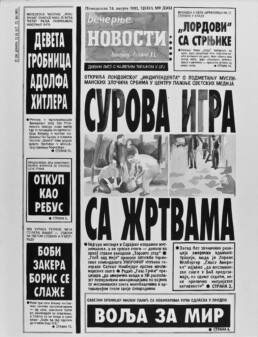VLADIMIR MILADINOVIĆ (1981)
Personal/Political
Rendered History Series
indian ink wash on watercolour paper
50.8 x 66 cm (7 psc)
2012–2013
Personal/Political
Rendered History Series
indian ink wash on watercolour paper
50.8 x 66 cm (7 psc)
2012–2013
These two drawings are part of the series for which Vladimir Miladinović was awarded at the 53rd October Salon – by the jury composed of Sarah Arrhenius, Magdalena Ziółkowska and Nikola Dedić.
The Collection includes seven drawings showing headlines such as: Officially – Assembly Centres, Towards Prisoners by World Standards, Imprisoned Serbs, Auch Im Vātikan Diskussion über militarische Aktion in Bosnien, Jugo-Generäle als Kriegsverbrecher von Gericht, Contract Massacre, A Cruel Play with Victims
Since 2012, Vladimir Miladinović has been following his daily routine in which he is devoted to archival research in the tabooed historical periods about which it is difficult to reach a broader social consensus.
By transferring, i.e., faithfully copying the collected material into the form of drawings, in the technique of ink wash, the artist makes a series of works through which he tries to establish a personal relation to the offered material. The works in this series are a kind of cathartic recollection, through which each viewer goes while reading the pages and articles – in the beginning only from Serbian newspapers of 1991 and 1992 – and compare them with their own inscribed knowledge of the events during the period of war in the territory of the former Yugoslavia, taken as the subject of the work.
In the later years, the research included the archive of articles about the same period from newspapers in Austria, Croatia, Spain and Ireland. The works, among other things, show some of the ways in which the dominant ideologies at a given moment carry out the process of ideological interpellation.
“The drawings were created as a result of a year-long research of the archival material kept at the National Library of Serbia in Belgrade. The subject of the research was the daily press from the early 1990s. Particular attention was paid to texts related to the war in Croatia and Bosnia and Herzegovina. These were daily newspapers from the territory of Serbia: Politika, Večernje novosti, Politika ekspres and Borba. Emphasis was placed on two historical periods, November 1991 and August 1992. These two periods are two important neuralgic points for the context of contemporary Serbia, when talking about the war on the territory of the former Yugoslavia. Both periods, viewed from the perspective of writing of the local press, give us a broader picture of what was happening in the recent past of Serbia and how, and these are also current issues in the new Serbian society. The current policies of remembrance of that period, the dominant narratives created today about these events, bring to the fore the question of personal responsibility, that is, how we will now relate to what is part of the public sphere of the society in which we live.”
Vladimir Miladinović, from the catalogue of the 53rd October Salon
© Cultural Centre of Belgrade, October Salon Collection and the artist
Gift Contract: III-15-44/20.3.2014. (4 pcs)
Inventory No. 1341
Purchase Contract: III-5-477/1/15.12.2014. (3 pcs)
Inventory No. 1382
Photo: Courtesy of the artist
Selected Bibliography:
53rd October Salon, Good Life: Physical Narratives and Spatial Imaginations. Cultural Centre of Belgrade, 2012
ABOUT THE AUTHOR:
Vladimir Miladinović (1981, Belgrade, Serbia) graduated from the Faculty of Applied Arts in Belgrade and completed his doctoral courses in interdisciplinary studies at the University of Arts in Belgrade. He was a member of the art/theory group “Four Faces of Omarska”, dealing with the questioning of memorial strategies in the territory of the former Yugoslavia. His work is focused mainly on reviewing the politics of memory, media manipulation, as well as the creation and interpretation of historical narratives. More information at http://vladimirmiladinovic.blogspot.com

